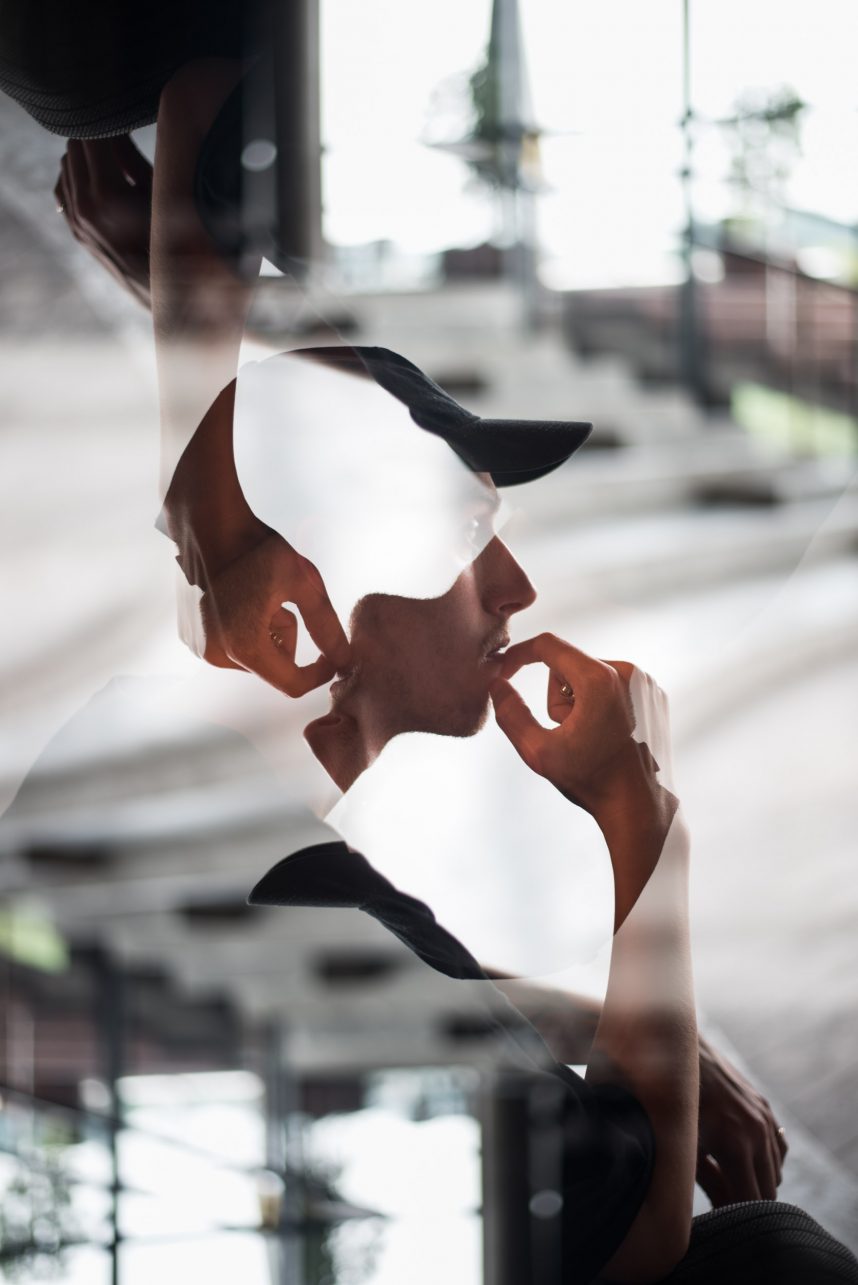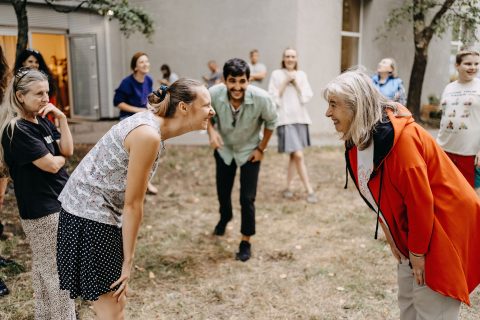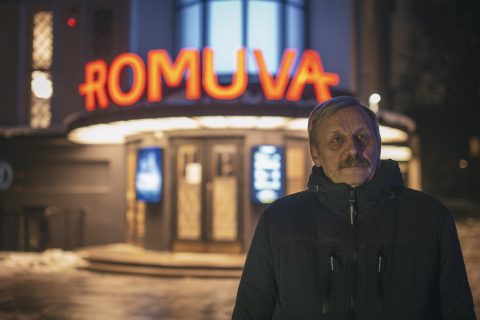Jacob Bray is a contemporary dance theatre creator and choreographer from the UK. Jacob’s work incorporates elements of dance, theatre, comedy, and speech. He’s interested in female empowerment, nightlife, world affairs, equality, and realness. In 2018, Jacob participated in Kaunas Biennial as an emerging artist with his work Laundry. He was the first internationally commissioned artist in Kaunas from the MagiC Carpets platform. Today we catch up with him as an emerging curator, too. We chat about the dance scene, sensitive topics, and reminiscence of the Laundry process. Also — how to make dance accessible?

Jacob, what are you working on right now?
I’m working with people from Folkestone Fringe. It’s an arts organization here in Folkestone, and we work on the MagiCs Carpets platform. I’m the emerging curator, too. Alongside, I do a host of other things. As a choreographer and director, I’m moving towards my next piece of work currently it’s in the initial stages. That will be mostly film work, but also a bit of dance. I hope to involve a lot of the artistic and residential communities here in Folkestone.
When reflecting on the beginning of your dance studies, you wrote: “It felt like I could scream through choreography.” Do you feel the same way now?
I remember feeling like that because, as a teenager, I was shy. I remember being in situations and not being able to speak up or say what I felt. But through choreography, I could. That’s what made me so passionate about it at the beginning. Obviously, as I’ve grown older and my artistic interests have changed, I’m more confident now. So, I still do scream through my choreography but it’s not so much about what I’m feeling or what I want to say. It’s about political issues, how others are feeling, how I can empower others. It’s different.
So, the things you’re screaming about have changed, but not the screaming itself?
Yeah. Also, I remember writing that because my choreography used to be kind of garish. It was quite punchy and loud. And now, ten years later, I find much more sensitivity in my work. But, you know, that’s because I’m feeling different as a person.
What are you the most sensitive about now?
Probably my family, my friends, and my relationships with people. Those things are important to me, and I think they’re important to celebrate in the work because everybody has them. What else? Money issues. Especially at the moment. You know, things like paying bills, calling mum, the normal things we all do. Everything going on in the world. Yeah, unfortunately, there are lots of terrible things going on. My brain is very active in the world news. Those kinds of topics always crop up in my work somehow, I think it’s important to shine a light on them.
In Lithuania, we also have choreographers who are now turning into almost social activists. How do you see the dance scene in general? What are the topics the dance world is now talking about?
I think it’s harder for choreographers to just be making work that’s just about the dance. It’s because of funding. Older companies can still do that because they’ve got a long legacy and an impact on the industry historically. But younger choreographers or companies need to be clever and think about how they would be funded — who’s going to pay for it and why.
And that means lots more people are working with the community. Lots more people are making collaborative work. I’ve seen that a lot. So, I don’t know about specific topics, but I know that the process in which people are working has changed.
For example, if I had an idea for a dance work, and I wanted to get funding, there is so much to think about. Who it is going to impact in the community, people that are going to be developed through it, and so on. And that ends up changing the whole creative process. I think it’s harder to get money for arts now, people have to be clever.

A few years ago, you had a project in Kaunas called Laundry. How do you remember it looking from time’s perspective?
Back then, I already had an established relationship with Folkestone Fringe. I mean, I wasn’t working with them as a curator, but I was fresh out of a university, and I really bonded with the team. I guess they liked my work. Then MagiC Carpets came. I think, back then, the curators had to pitch ten artists to everybody. And so, the curator, Neringa Kulik, picked me to come and create work in Kaunas.
I was the first artist to be hosted in Kaunas, which was amazing. And it was my first international commission. So, it was exciting, but also quite daunting for me. However, I really enjoyed it. And grew as an artist. And made some fantastic friendships in Kaunas. That’s important to me.
I just feel like there’s a driving force in Kaunas. It comes from the people because everybody is really passionate.
How was the process?
When I went there, I was feeling a bit of frustration inside me about the industry. And I wasn’t happy with the way I was working back then. It felt like I would go into the studio, make the work, and then it would look nice. It would feel good for the audience to watch it, but that’s kind of all it was. So back then, I was talking a lot about the glory of performance and, you know, I just didn’t feel that was the path I wanted to take in my career.
I really care about people and the community, and I knew there must be a way to marry my work with this passion.
So, when I went to Kaunas, I thought, right, I have no idea what I’m going to do here. And I’m going to completely just take a different process than I would normally take. It was really difficult, actually.
But I worked with a group of all-female performers, and they were all from different artistic backgrounds. For example, one of them was a painter. She hadn’t done any work for stage before. But she was interested in it. However, she felt like she had no confidence to ever do it.
So, I met these people with these stories. And I thought: right, this is what I’m going to work with. I worked with all of them kind of individually. In the end, whatever I made with those people, I stitched together to be one piece.
I guess that kind of a process has stuck with me. Even now, I like to find the people I want to work with, and then work with their stories or their experiences. I think it just makes work much richer, and true. And people relate to it much more because it’s about real things. Real emotion and trueness.
What was that common thread in those individual stories?
It was about new experiences, growing, and overcoming. I wanted to give other people the voice and the chance to lead. Obviously, I gave the direction, but it was really about what they wanted to say and how they were feeling about life. So, I guess that was probably the common thread, you know? Just things they wanted to share. Not that I was digging. It wasn’t like therapy. But I guess the process was probably quite therapeutic. It certainly was for me.

One of the artists who worked on the project, your colleague Amy, said in one interview that it’s important for you to allow women to use their voices. Is it still the same?
Back then, I was frustrated because, in the dance industry, men got much more opportunities and exposure than women. It’s just really sexist. And I’ve experienced it throughout my career. I’ve been given the opportunity above somebody who’s a woman definitely more able than me. Just because I’m a man. There are not as many men working in the industry as there are women. And I was really angry about that at the time. That’s why in that work, I worked exclusively with women. Now, I work with men in my pieces, but I really care about equality. If there’s ever an opportunity for me to do a bit of activism through the work, I do it.
Do you remember your first impressions about Kaunas and its artistic vibe?
I loved Kaunas and it’s still one of my favourite places. I remember the city feeling very fresh and vibrant, and there was loads of energy. I still feel that now, when I go there. I just feel like there’s a driving force there. It comes from the people because everybody is really passionate. It feels like a city where things happen.
What’s your relationship with MagiC Carpets now?
My residency in Kaunas was the only time I worked as an artist on MagiC Carpets. But Folkestone Fringe hosted artists in my hometown, so sometimes I was involved with some of the projects there. It’s such an amazing platform — the way it works is really clever. It’s fantastic for networking. Meeting people and engaging the local community is so important and it’s something I care about. So, when our old curator moved away, there was a position available for an emerging curator, and I took it.
How is this new role of a curator?
It’s a very new role for me, but I really enjoy learning. Especially sitting amongst a team of such fantastic role models. Every time I talk with any of them, my brain becomes a sponge, and I try and learn as much as possible. But it’s also an interesting relationship with me working as an artist and a curator. Especially with the process I take as an artist, because there are some similarities there. I’m still learning to switch off my artist role and move into a curator role. But I’m getting there and I’m feeling good about it.
Is there anything else in regard to your professional portrayal?
I don’t think so. Well, I mean, I work with a group of very young children in a forest school setting. I love that work because I can use my dance training and expertise with these young kids. The job allows me to play, and it keeps my brain creative and playful.
Your initial medium is the body. But you’re also interested in spoken word and you add it to your pieces. In your work Pass the Phone, the verbal part is very much expressed. Why do you combine those seemingly opposite mediums, verbal and nonverbal?
The verbalness, for me, captures the essence. It captures emotion, social aspects, it captures relationships and political aspects of the work. The spoken word is kind of the most important aspect there. Especially when I’ve captured just everyday conversations between people, or phone calls. Because everybody has phone calls. It makes the work accessible. It gives you a sense of something, but it’s not telling you what it is. And the movement acts like a brush stroke or highlighter. The two are intrinsically linked. I feel they’re emotionally connected somehow.
I read you’re interested in nightlife, and club culture. What attracts you about that as an artist?
Freedom and expression. Also, a sense of belonging and feeling safe with people. As I’m growing older, I’m moving further away from that. But there’s definitely something. Especially the music, different genres. It’s something that will always stay with me.
When people come to watch my work, I like for it to feel like a night out. Where audiences can come and have a drink and talk and meet new people. There’s music, then they watch the work, and then there’s more music.
It adds to the accessibility of the work. I think about my parents: where would they feel comfortable? And my friends who are not artists. What would make them want to come and watch my work? They need to have fun. I think it’s really important. The work takes an emotional journey, so there are moments of sadness. But everybody still has a fun time throughout the night. It’s about accessibility.
* MagiC Carpets is a platform actively uniting 16 European partners and intended for traveling emerging artists to work in socially engaged and responsible art fields (visual art, public art, community art, exhibitions, performances, documentary theatre, online art, etc.) to research and to implement new productions together with local artists and local communities. Co-funded by the EU and Lithuanian Council for Culture.




